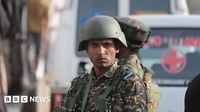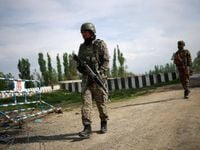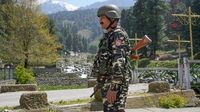A ruthless act of terror has shattered the serenity of Pahalgam, a popular tourist destination in Jammu and Kashmir. This recent attack, which claimed the lives of 26 people, is a chilling reminder that peace in the Kashmir Valley remains precarious. The attack was not merely an assault on civilians but a calculated strike timed with the visit of US Vice President JD Vance, raising serious questions about the security measures in place.
Intelligence estimates suggest that approximately 60 foreign terrorists are currently operating in the Kashmir Valley, with around half of them linked to The Resistance Front (TRF), a proxy outfit for the notorious Lashkar-e-Taiba. This group has adopted a new form of hybrid terrorism, utilizing radicalized locals who can blend into civilian life, making them harder to track and counter. Such tactics complicate the security landscape, as these operatives often leave no digital footprint or family ties, making conventional intelligence gathering increasingly challenging.
The attack, which occurred on April 22, 2025, during the peak tourist season, has already begun to have significant repercussions on the local economy. Kashmir welcomed over two crore domestic and foreign tourists in 2023, but the recent violence has instilled fear, prompting tourists to cancel their bookings and airlines to scale back flights. Local businesses, particularly those reliant on tourism, are bracing for a staggering economic loss as the region faces yet another dilemma in a long-standing conflict.
Among the victims was Navy officer Vinay Narwal, who was on his honeymoon when he was shot dead in front of his wife. His tragic death underscores the brutal reality that even in the most cherished moments, violence can strike without warning. Eyewitness accounts describe a scene of chaos as militants targeted male tourists, asking for their names before executing them. Survivors recounted harrowing experiences, with one professor, Debasish Bhattacharyya, stating that he recited the "Kalima" in a moment of desperation, which he believes spared his life.
As the investigation unfolds, the Jammu and Kashmir Police have identified two Kashmiri men, Adil Guri and Ahsan, as potential suspects. Both had previously traveled to Pakistan and are believed to have returned with a group of militants. The police have released sketches based on eyewitness accounts, indicating that the attackers were armed with AK series rifles and utilized helmet-mounted cameras to document their assault.
The Indian government has responded swiftly to the attack, with Defence Minister Rajnath Singh pledging a robust retaliation against those responsible. Moreover, India's Foreign Ministry has declared that Pakistani nationals will no longer be permitted to travel to India under the SAARC visa exemption program, effectively canceling all previously issued visas. This decision reflects the heightened tensions between the two nations, exacerbated by the recent violence.
World leaders have also expressed their condemnation of the attack. Israeli Prime Minister Benjamin Netanyahu described it as a "barbaric" act, while leaders from Italy, France, and the United States echoed similar sentiments. President Donald Trump extended his condolences and reaffirmed the US's support for India in its fight against terrorism.
As the security situation in Kashmir deteriorates, the Indian government faces mounting pressure to reassess its counter-terrorism strategies. The current reliance on technology, such as drones and surveillance, has proven insufficient against the evolving tactics of hybrid terrorists. There is a pressing need for a return to traditional counter-insurgency methods, including increased boots on the ground and enhanced human intelligence (HUMINT) capabilities.
Political leaders are calling for a thorough review of the security and intelligence framework in the region. The recent attack has highlighted significant lapses in threat perception and inter-agency coordination, prompting calls for accountability among those responsible for national security. As the government prepares for intensified counter-terror operations, there is a fear that the measures may alienate ordinary citizens, further complicating an already fragile situation.
The Pahalgam attack serves as a stark reminder that the fight against terrorism in Kashmir is far from over. The region, which has experienced a surge in targeted killings since the revocation of its semi-autonomy in 2019, now faces a renewed challenge. As the Indian state grapples with the dual threats of cross-border terrorism and internal discontent, the resilience of the local communities will be tested.
In the aftermath of this tragedy, it is crucial for the Indian government to balance its counter-terrorism efforts with the need to maintain trust and cooperation with local populations. The people of Kashmir, who have long suffered from both foreign-fueled terror and political instability, deserve a comprehensive approach that prioritizes their safety and well-being.
As the summer approaches, the situation in Kashmir is expected to remain tense. Increased security measures may lead to curfews and heightened military presence, adding to the strain on local communities. The government must navigate these challenges carefully, ensuring that its actions do not inadvertently exacerbate the cycle of violence and resentment.
The Pahalgam terror attack is not just a tragedy; it is a wake-up call for India to reassess its strategies and reaffirm its commitment to ensuring peace and security in the region. The stakes have never been higher as the country seeks to protect its citizens and restore confidence in its ability to maintain order in a volatile landscape.









